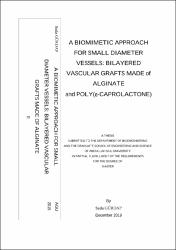| dc.contributor.author | GÜRDAP, Seda | |
| dc.date.accessioned | 2021-12-27T13:05:08Z | |
| dc.date.available | 2021-12-27T13:05:08Z | |
| dc.date.issued | 2019 | en_US |
| dc.date.submitted | 2019-12 | |
| dc.identifier.uri | https://hdl.handle.net/20.500.12573/1101 | |
| dc.description.abstract | Cardiovascular diseases (CVDs) still remain one of the leading causes of morbidity and mortality across the world. A typical symptom of CVDs is the vascular occlusion. There are many strategies for treatment such as angioplasty, stent application and bypass grafting. Although synthetic blood vessels are successfully used in bypassing of the medium (>10 and<6) and large sized (10 mm) vessels, they have high failure problem for the replacement of small diameter ( 6 mm) vessel because of early thrombosis formation. Tissue engineering, mimicking the structural, mechanical and cell growth characteristics of the native vessels is a promising treatment method for CVDs. In this study, it was aimed to fabricate a bilayered vascular scaffold by combining thermally induced phase separation and electrospinning methods. First, alginate porous layer was produced as the inner layer with the average pore diameter of approximately 100 μm to enable endothelial cell attachment and proliferation. Then, the inner layer was covered with electrospun polycaprolactone (PCL) membrane to strength the endurance of vascular graft. The mechanical test showed that the bilayered vascular scaffold has a close mechanical characteristic to native vessels with elastic modulus of 2 .45 1.7 MPa and estimate burst pressure of 0,18 MPa. Also, heparin was chemically immobilized to scaffold to elongate the release time, which can result in reduced thrombosis. In addition, cross-linked scaffold lost 21% of its mass for 6 weeks showed the moderate degradation level that can support the neotisue formation via cell migration to the scaffold, while the scaffold is synergistically degraded. According to the results, the materials prepared by biomimetical approach revealed that they have a great potential to be used as a synthetic vascular graft. | en_US |
| dc.language.iso | eng | en_US |
| dc.publisher | Abdullah Gül Üniversitesi, Fen Bilimleri Enstitüsü | en_US |
| dc.rights | info:eu-repo/semantics/openAccess | en_US |
| dc.subject | Tissue engineering | en_US |
| dc.subject | Bilayered vascular grafts | en_US |
| dc.subject | Thermally induced phase separation | en_US |
| dc.subject | Electrospinning | en_US |
| dc.title | A BIOMIMETIC APPROACH FOR SMALL DIAMETER VESSELS: BILAYERED VASCULAR GRAFTS MADE of ALGINATE and POLY(-CAPROLACTONE) | en_US |
| dc.type | masterThesis | en_US |
| dc.contributor.department | AGÜ, Fen Bilimleri Enstitüsü, Biyomühendislik Ana Bilim Dalı | en_US |
| dc.relation.publicationcategory | Tez | en_US |


















